Standard Bind-Offs
 The bind-offs in this section work well for binding off Stockinette-stitch and Garter-stitch fabrics.
The bind-offs in this section work well for binding off Stockinette-stitch and Garter-stitch fabrics.
They are moderately to very stretchy and most of them are good for beginners. Beginning knitters should know the Standard Bind-Off with its font, top, and back variations.
My favorite bind-off in this section is the Standard Bind-Off because it’s good in almost every situation.
It’s also the building block for almost every other more-complicated bind-off.
I also really like the Elastic Bind-Off because it’s stretchy and not very difficult.
About edges rolling: most edges on Stockinette stitch will roll. You can block your work to prevent this.
Some bind-offs will roll no matter what (I’ll tell you if this is the case), and you should choose them knowing that. You can use the Standard Bind-Off top and back variations to prevent rolling, as well as the Braided Rib Bind-Off.
Standard Bind-Off Sampler Instructions


With white yarn, CO 96 sts (this will be a lot so you may need to use a circular needle).
Work in 1×1 rib for 5 rows.
With orange yarn, work in St st for 4 rows (starting with a k row).
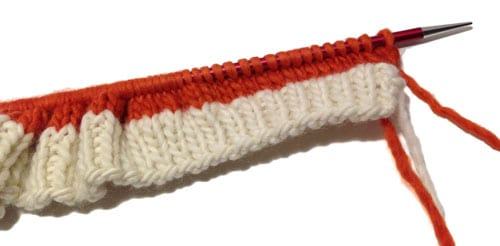
- BO the first 12 sts using the Standard Bind-Off.
- Starting from step 2 (1 st already on R needle), BO 12 sts using the Suspended Variation Bind-Off. When done, move st from R needle back to L needle.
- BO 12 sts using the Decrease Bind-Off.
- Put the st that’s on the R needle onto a crochet hook. Starting with step 2, BO 12 sts using the Crochet Bind-Off. When done, place the st that’s on the crochet hook onto the right needle.
- Starting from step 2 (1 st already on R needle), BO 12 sts using the Elastic Bind-Off. When done, move st from R needle back to L needle.
- BO 12 sts using the Icelandic Bind-Off.
- Starting from step 3 (1 st already on R needle), BO 12 sts using the Braided Rib Bind-Off. When done, move st from R needle back to L needle.
- BO remaining sts using the EZ Sewn Bind-Off.
Lightly block this sampler to prevent the edge from rolling.
The Bind-Offs
Standard Bind-Off

This is a beginner bind-off that is the basis for most of the bind-offs in this dictionary.
This bind-off is moderately stretchy. It is good for Stockinette stitch fabric and you would it use when you’re just learning how to bind-off or any time you want a basic, no-fuss edge.
Even if you’re an immediate knitter, I suggest that you review the tips and the video for this bind-off, because you’ll learn the correct technique that you’ll need to apply to the other, more complex bind-offs.
This bind-off will roll if you use it on Stockinette stitch unless you block it.
This bind-off also has three variations.
- Front Variation (Default): The chain of stitches appears along the front. To do it, knit every stitch.
- Top Variation: The chain of stitches appears along the top, and is reversible. To do it, alternate between knitting and purling your stitches as you bind off.
- Back Variation: The chain of stitches appears along the back. To do it, purl every stitch OR turn your work around and do the Front Variation on the WS of the work.
I would consider all three variations of this bind-off “required reading” for beginning knitters.
Practice getting this bind-off smooth and even, especially the part where you lift one stitch over the other and off the needle. If that’s hard for you to get right, practice it on a long swatch until the movement is smooth and even and the stitches are not too tight or too loose.
In this technique you will learn an abbreviation which will be used throughout the course:
- BO 1 means “bind-off 1” — pass the second stitch on the right-hand needle over the second stitch and off the right-hand needle.
Matching Cast-On: Chain Cast-On
Similar Bind-Offs:
- The Suspended Variation Bind-Off is based on this bind-off.
- The Decrease Bind-Off: you don’t have to lift one stitch over another, so if you are having tension issues on this bind-off, try the Decrease Bind-Off.
- The Crochet Bind-Off is similar but is done with a crochet hook.
Restricted Video
 This video is available to customers of the following class(es):
This video is available to customers of the following class(es):
Click the links above to learn more about the class(es) OR Join KnitFreedom Premium now and get this and every other video we sell FREE.
If you own this class or are a member of Premium, please LOG IN to watch.
To Do the Standard Bind-Off:
- K1.
- K1.
- Insert L needle tip into 2nd st on R needle.
- BO 1 (pass 2st st over 1st st and off needle).
- Repeat steps 2-4 across.
- Cut yarn, leaving a 6-inch tail for weaving in later.
- Grab tail through rem loop, pull tail through and tighten.
Click image to play. If GIF doesn’t play immediately when clicked, wait 20-30 seconds. Click the GIF again to stop.
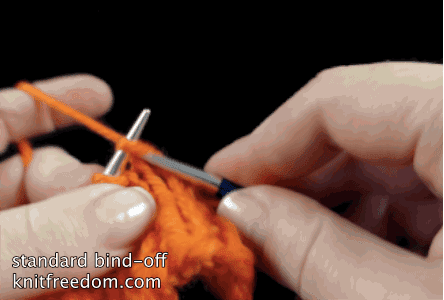
Suspended Bind-Off (Variation)

This is a fast and easy bind-off that is based on the Standard Bind-Off and is a bit stretchier.
Its main benefit is that it can help your stitches come out more evenly if you have trouble getting a good, even tension on the Standard Bind-Off, especially if the difficulty you have is binding off too tight.
Even if you don’t have trouble with your tension, you should learn this bind-off because it uses a basic technique (the “suspended” bit) that is used on some more complex bind-offs, namely the Frilled Standard Bind-Off and the Frilled Decrease Bind-Off.
This is called the suspended bind-off variation because this is a variation on the Suspended Bind-Off. I’ve chosen to teach you the variation instead of the original because the variation comes out the same and it’s easier to do.
Matching Cast-On: Chain Cast-On
Similar bind-offs: Standard Bind-Off
A technique in this bind-off is also used in: Frilled Standard Bind-Off, Frilled Decrease Bind-Off
Restricted Video
 This video is available to customers of the following class(es):
This video is available to customers of the following class(es):
Click the links above to learn more about the class(es) OR Join KnitFreedom Premium now and get this and every other video we sell FREE.
If you own this class or are a member of Premium, please LOG IN to watch.
To Do the Suspended Bind-Off (Variation):
- K1.
- K1. Do not remove st from L needle.
- BO 1.
- Drop loop from L needle.
- Repeat steps 2-4 across row.
- Cut yarn and pull through last stitch.
Click image to play. If GIF doesn’t play immediately when clicked, wait 20-30 seconds. Click the GIF again to stop.
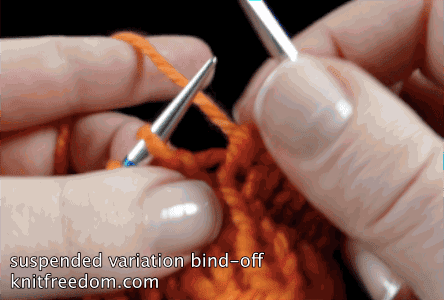
Decrease Bind-Off
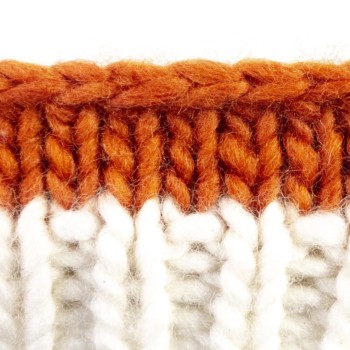
This is an easy, medium speed bind-off. It’s about as stretchy as or a little stretchier than the Standard Bind-Off.
One benefit to this bind-off is that it might help you with your tension, because it’s one of the few bind-offs that doesn’t require you to lift one stitch over another other stitch.
I chose to put this bind-off in the course because it’s a nice building block for some of the more complicated bind-offs.
Matching Cast-On: Chain Cast-On
A technique in this bind-off is also used in: Knit 2 Together Bind-Off, Cable Bind-Off, Icelandic Bind-Off, and Elastic Bind-Off.
Restricted Video
 This video is available to customers of the following class(es):
This video is available to customers of the following class(es):
Click the links above to learn more about the class(es) OR Join KnitFreedom Premium now and get this and every other video we sell FREE.
If you own this class or are a member of Premium, please LOG IN to watch.
To Do the Decrease Bind-Off:
- K2togtbl.
- Move st from R needle back to L needle.
- Repeat steps 1-2 across.
- Cut yarn and pull through last stitch.
1.
To do the bind-off faster, combine steps 2 and 1.


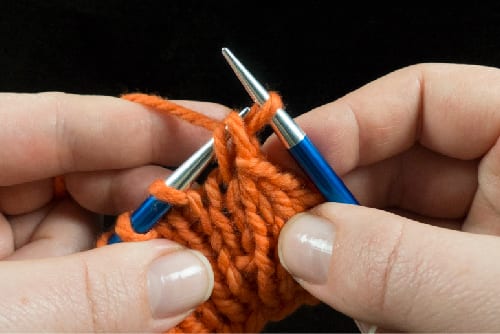
Click image to play. If GIF doesn’t play immediately when clicked, wait 20-30 seconds. Click the GIF again to stop.
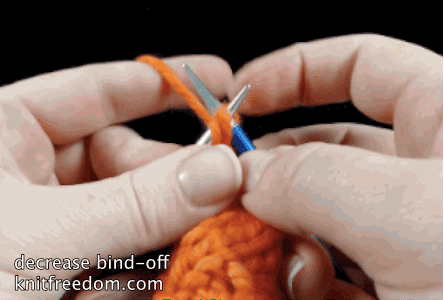
Crochet Bind-Off
Cap Sease, the author of Cast On, Bind-Off, says that this bind-off is good for projects made with non-stretchy yarns like silk or cotton because it doesn’t require you to lift one stitch over another other stitch, and therefore it might be easier for you to control the stitch size.
She also says this bind-off works nicely if you are going to work a crochet border into the edge after you finish binding-off.
I recommend that if you do this bind-off you use a crochet hook that is one size smaller than called for on the yarn because this bind-off can tend to flare out a bit.
I personally wouldn’t use this bind-off much, because I feel like the Standard Bind-Off gives you the same results with a faster and easier technique, but I included it in this course because other books gave some valid reasons for trying it.
Matching Cast-On: Chain Cast-On
Restricted Video
 This video is available to customers of the following class(es):
This video is available to customers of the following class(es):
Click the links above to learn more about the class(es) OR Join KnitFreedom Premium now and get this and every other video we sell FREE.
If you own this class or are a member of Premium, please LOG IN to watch.
To Do the Crochet Bind-Off:
- Insert hook through 1st st as if to knit. Wrap yarn.
- Pull loop through st. St comes off needle.
- Insert hook through next st as if to knit. Wrap yarn.
- Pull loop through st. St comes off needle.
- Pull 1st st on hook through 2nd st.
- Snug yarn.
- Repeat steps 3-6 across.
- Cut yarn and pull through last stitch.
Click image to play. If GIF doesn’t play immediately when clicked, wait 20-30 seconds. Click the GIF again to stop.

Elastic Bind-Off

This is a fast bind-off which I really like.
It’s a good stretchy bind-off for beginners. To be more exact — it is very stretchy for binding off on Stockinette stitch, and moderately stretchy on ribbing.
It also looks decorative, which is unique and unusual for the standard bind-offs.
Keep in mind that this bind-off will roll on Stockinette stitch. Just plan on that being a feature of the bind-off — maybe knit a couple extra rows before binding off to make up for the roll.
This bind-off would be nice on something like fingerless mitts, where the moderate stretch and decorative rolled look would work well.
This bind-off is also used in: Picot/Purled Hemmed Edge Bind-Off
Other stretchy bind-offs in this section are: Icelandic Bind-Off, EZ Sewn Bind-Off
This bind-off is part of the Intermediate bind-off challenge
Restricted Video
 This video is available to customers of the following class(es):
This video is available to customers of the following class(es):
Click the links above to learn more about the class(es) OR Join KnitFreedom Premium now and get this and every other video we sell FREE.
If you own this class or are a member of Premium, please LOG IN to watch.
To Do the Elastic Bind-Off:
- K1.
- K1.
- Insert L needle tip into 2 front loops of sts on R needle.
- Wrap the yarn and k the sts together.
- Repeat steps 2-4 across.
- Cut yarn and pull through last stitch.
Click image to play. If GIF doesn’t play immediately when clicked, wait 20-30 seconds. Click the GIF again to stop.

Icelandic Bind-Off
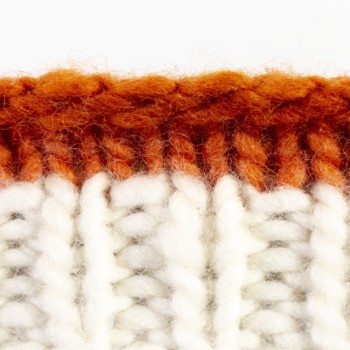
This is a fantastic stretchy bind-off that even many advanced knitters have not heard of.
It’s one of the three stretchiest standard bind-offs (the other two being the Elastic Bind-Off and EZ Sewn Bind-Off).
It’s also amazing for Garter stitch.

This is my #1 recommended bind-off for binding off on garter stitch.
See how this bind-off compares to other good bind-offs for Garter stitch in Bind-Offs for Garter Stitch.
Be warned that this edge will roll if you do it on Stockinette stitch, so just make sure that that’s a feature that you want on your knitting.
A technique used in this bind-off is also used in: Japanese Bind-Off
Other stretchy bind-offs in this section are: Elastic Bind-Off, EZ Sewn Bind-Off
This technique is part of the Advanced Bind-Off Challenge
Restricted Video
 This video is available to customers of the following class(es):
This video is available to customers of the following class(es):
Click the links above to learn more about the class(es) OR Join KnitFreedom Premium now and get this and every other video we sell FREE.
If you own this class or are a member of Premium, please LOG IN to watch.
To Do the Icelandic Bind-Off:
- With R needle, reach through 1st st purlwise.
- Catch front loop of 2nd st.
- Draw 2nd st through 1st st.
- Wrap your yarn to knit. Pull yarn through.
- Complete the K stitch.
- Move st back to L needle.
- Repeat steps 1-6 across row.
- Cut yarn and pull through last st.
One thing to help you do this bind-off faster is to get into a rhythm.
Don’t be afraid to stretch the stitches as you do them so that you can get into a rhythm and make sure that the bind-off comes out nice and even.
If your tension varies a lot you’ll notice the bind-off won’t look as nice.
You will already be in position to catch the front loop of the second stitch and start the movement again.

This will keep the stitches from getting too tight.

Click image to play. If GIF doesn’t play immediately when clicked, wait 20-30 seconds. Click the GIF again to stop.

Braided Rib Bind-Off

This is a very easy bind-off.
It’s fast and firm and it does not roll, especially if you block it.
The thick braid gives it a simple but decorative look. It would be really nice on the edge of something like a potholder or a dishcloth where you don’t need a stretchy edge and you’d prefer the bind-off to lay flat.
To do this bind-off, you will need an extra strand of yarn that’s about three times the width of the stitches to be bound off.
You can use the yarn from the other end of the ball for this purpose if you want. All this bind-off is is basically a purled Standard Bind-Off using a double strand of yarn.
Matching Cast-Ons
- The Old Norwegian Cast-On looks similar to this bind-off.
- This would match the Twined 2-Color Cast-On with a Contrasting Edge, if you did this bind-off on a fabric with vertical stripes and used a 3rd contrasting color for the bind-off. To set this up, work the WS row previous to the bind-off in the 3rd color.
Based on: Standard Bind-Off (back variation)
Other standard bind-offs that lay flat: Standard Bind-Off (top variation)
Restricted Video
 This video is available to customers of the following class(es):
This video is available to customers of the following class(es):
Click the links above to learn more about the class(es) OR Join KnitFreedom Premium now and get this and every other video we sell FREE.
If you own this class or are a member of Premium, please LOG IN to watch.
To Do the Braided Rib Bind-Off:
- Hold a second strand of yarn with your working yarn. Leave a 6-inch tail hanging down.
- P1.
- P1.
- BO 1.
- Repeat steps 3-4 across.
- Cut yarn and pull through last st.
Click image to play. If GIF doesn’t play immediately when clicked, wait 20-30 seconds. Click the GIF again to stop.
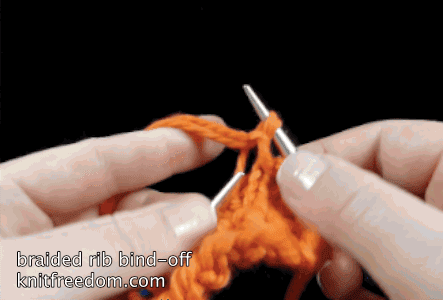
EZ Sewn Bind-Off

This bind-off is very stretchy but, importantly, bounces easily back into shape. Nobody likes a stretched-out bind-off.
It’s great on Garter stitch and Stockinette stitch as well.
When I tried this bind-off I was surprised at how easy it was. It really only has two movements so, as an introduction to sewn bind-offs, this one is great.
This bind-off does have the tendency to roll forward, which is fine as long as it doesn’t take you by surprise. It is also quite slow (which is the norm for sewn bind-offs of any kind).
A warning for you about sewn bind-offs and delicate yarn: Any time that you’re using a delicate yarn, you’ll want to be careful when doing a sewn bind-off because you are pulling on the yarn more than you would for a knitted bind-off.
If you are using a delicate, one-ply yarn like Noro or Malabrigo Worsted, it could break.
I don’t think that will happen in this case, because you’re not putting a lot of stress on the yarn in this bind-off, but it’s important to know.
Also be careful because, like all sewn bind-offs, this bind-off is difficult and time-consuming to undo. Basically you have to take your tapestry needle and go back the way you came, slowly retracing your steps and putting each stitch back on the needle.
Therefore, you may want to try this bind-off on a small swatch before you do it on a larger project, just to make sure you understand it before using it on hundreds of stitches.
Matching Cast-On: Long-Tail Cast-On
Similar to: Latvian Bind-Off (which I prefer to this bind-off)
Other stretchy bind-offs in this section are: Icelandic Bind-Off, Elastic Bind-Off
Restricted Video
 This video is available to customers of the following class(es):
This video is available to customers of the following class(es):
Click the links above to learn more about the class(es) OR Join KnitFreedom Premium now and get this and every other video we sell FREE.
If you own this class or are a member of Premium, please LOG IN to watch.
To Do the EZ Sewn Bind-Off:
- Cut yarn, leaving a tail 3x the width of the edge to be bound off + 6 in. for weaving in later.
- Thread yarn onto a tapestry needle.
- With tapestry needle, go purlwise in to 1st 2 sts on L needle. Pull yarn through.
- Go knitwise into 1st st on L needle. Pull yarn through.
- Push 1st st off L needle.
- Repeat steps 3-5 across.
- Cut yarn and pull through last stitch.
Click image to play. If GIF doesn’t play immediately when clicked, wait 20-30 seconds. Click the GIF again to stop.



